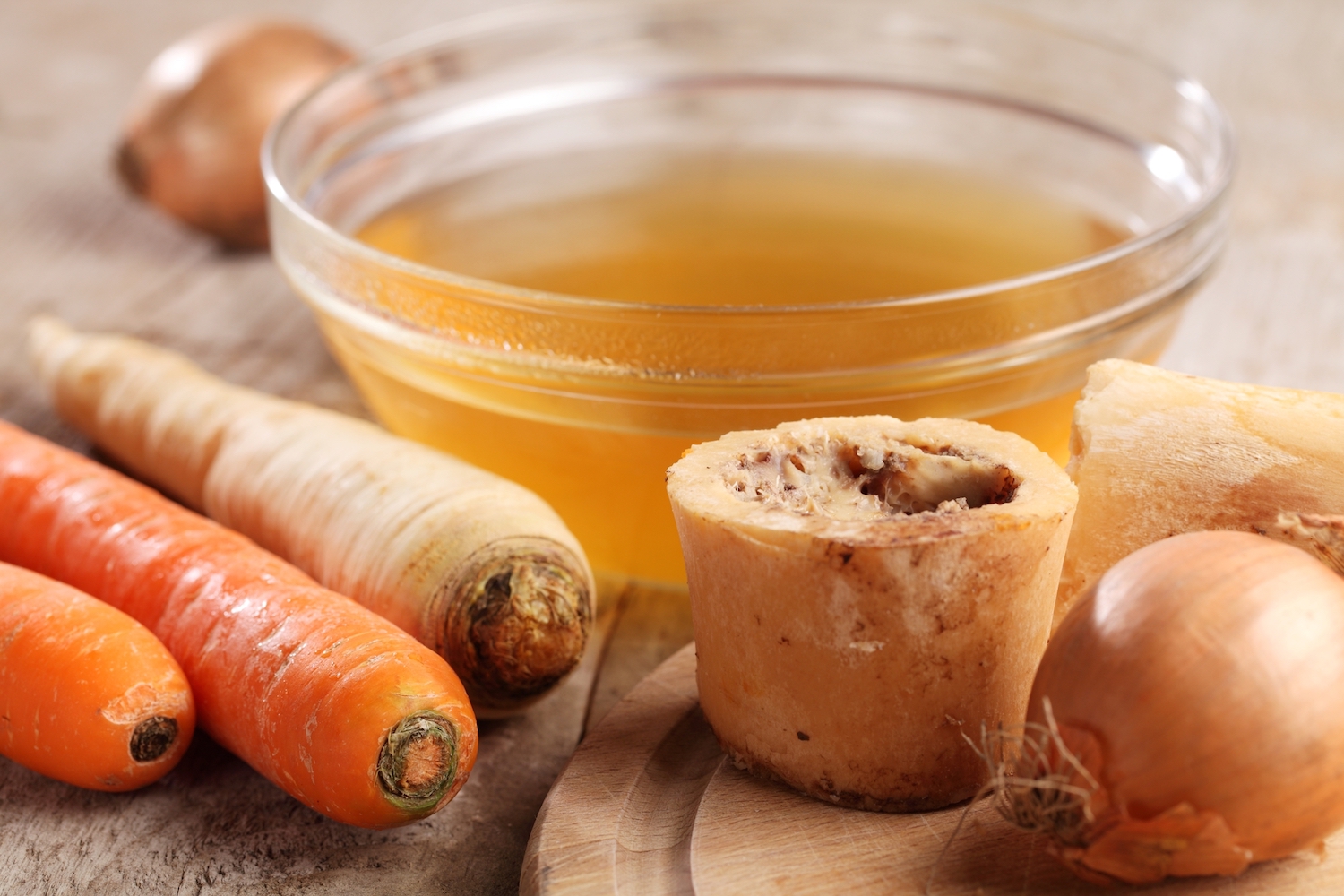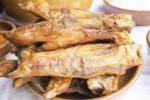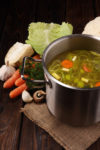
How to Make Soup Stock
So many recipes from 1800s cookbooks call for soup stock and all good cooks kept a supply on hand.
INFORMATION BELOW FROM 1800s COOKBOOKS
MEANING AND USE OF STOCK
Soup stock may be regarded as a liquid containing the juices and soluble parts of meat, bone, and vegetables, which have been extracted by long, slow cooking and which can be utilized in the making of soups, sauces, and gravies. Keep stock in small jars in a cool place. It makes a good gravy for hash meats and one tablespoon of it is sufficient to impart a fine flavor to a dish of macaroni and various other dishes. Good soups of various kinds are made from it at short notice. Slice off a portion of the jelly, add water, and whatever vegetables and thickening preferred. It is best to partly cook the vegetables before adding to the stock, as much boiling injures the flavoring of the soup. Season and boil a few moments and serve hot.
MAKING STOCK
In order to have good soup, you must first begin with good stock. Although the making of stock or soup is a simple process, it must necessarily be a rather long one. The reason for this is that all flavor cannot be drawn from the soup materials unless they are subjected to long, slow cooking at a temperature lower than the boiling point. To make stock, use fresh meat, bones (cracking the larger ones in order to extract the marrow), or bones and meat left over from a roast or broil, and put either or all of these in a large pot or soup kettle with water enough to cover. Let these simmer slowly, taking care to keep the vessel covered, stirring frequently, and occasionally pouring in a cup of cold water and skimming off the scum. It is only where fresh meat is used that cold water is applied; for cooked meat, use warm. The bones dissolved in the slow simmering furnish the gelatin so essential to good stock. One quart of water to a pound of meat is the average rule. Six to eight hours of cooking renders it fit for use. Let stand overnight, skim off the fat, put in an earthen jar, and it is ready for use. Every family should keep a jar of the stock constantly on hand, as by doing so any kind of soup may be made from it in from ten to thirty minutes.
NATURE, USE, AND CARE OF THE STOCK POT
The stock pot should be made of either enamel or earthenware, since a metal pot of any kind is liable to impart flavor to the food. Likewise, its lid should be tight-fitting. Then it will be an excellent utensil in which the materials may be stored until they are to be heated; when they can be poured or dipped into a saucepan or kettle. The stock pot must be kept scrupulously clean. No stock pot should ever be allowed to stand from day to day without being emptied, thoroughly washed, and then exposed to the air for a while to dry.
MEAT USED IN MAKING STOCK
With the exception of pork, almost every kind of meat, including beef, veal, mutton, lamb, game, and poultry, is used for soup making. Occasionally, ham is employed, but most other forms of pork are seldom used to any extent. When soup stock is made from these meats, they may be cooked separately or several kinds may be combined. For instance, mutton used alone makes a very strongly flavored soup, so it is usually advisable to combine this kind of meat with another meat that has a less distinctive flavor. On the other hand, veal alone does not have sufficient flavor, so it must be combined with lamb, game, fowl, or some other well-flavored meat.
Certain cuts of meats are preferred to others in the making of soups because of the difference in their texture. The tender cuts, which are the expensive ones, should not be used for soups as they do not produce enough flavor. The tough cuts, which come from the muscles that the animal uses constantly are usually cheaper, but they are more suitable because they contain the material that makes the best soup. The pieces best adapted to soup making are the shins, the shanks, the lower part of the round, the neck, the flank, the shoulder, the tail, and the brisket. Stock made from one of these cuts will be improved if a small amount of the fat of the meat is cooked with it. The marrow of the shin bone is the best fat for soup making. To avoid soup that is too greasy, any excess fat that remains after cooking should be carefully removed.
FLAVORING STOCK
It is the flavoring of stock that indicates real skill in soup making. In fact, the large number of ingredients found in soup recipes are, as a rule, the various flavorings, which give the distinctive flavor and individuality to a soup. Very often certain spices or certain flavoring materials may be omitted without any appreciable difference, or something that is on hand may be substituted for an ingredient that is lacking. Care should be taken not to allow any one particular flavor to predominate. Each should be used in such quantity that it will blend well with the others. A very good way in which to fix spices and herbs that are to flavor soup is to tie them in a small piece of cheesecloth and drop the bag into the soup pot. They will remain together, so that while the flavor can be cooked out, they can be more readily removed from the liquid than if allowed to spread through the contents of the pot.
KEEPING STOCK
Soup stock, like many other foods, spoils quite readily. Therefore, in order to keep it for at least a few days, it must receive proper attention. At all times, the vessel containing stock should be tightly closed and, especially in warm weather, the stock should be kept as cold as possible. Stock that is heavy enough to solidify into a jellylike consistency when it is cold will keep better than stock that remains liquid. The addition of salt or any spicy flavoring also helps to keep stock from deteriorating because these materials act as preservatives. Bacteria may be kept from entering stock if, instead of removing the grease, it is allowed to form in a solid cake over the top. No matter which of these precautions is taken to prevent stock from spoiling, it should be heated to boiling point once a day when it is to be kept for several days.
Image from Deposit Photos
=================================================
Do You Ever Make Your Own Soup? Please Leave a Comment Below.
=================================================




8 thoughts on “How to Make Soup Stock”
I’ll have to give this one a try. So far I’m a miserable failure at making stock from scratch.
I hope you have success. You might try a slow cooker or pressure cooker like an instant pot. Then you wouldn’t have to watch it.
We make stock with our turkey carcass after Christmas and Thanksgiving, but use it up right away with a big pot of turkey and vegetable soup.
I do the same thing. The carcass makes some delicious basic stock and I add all kinds of vegetable and turkey scraps for a wonderful soup.
I like thick soups, too. I made baked potato soup for the first time this week – full of butter, cheese and half and half and baked potatoes. It was wicked good except for all the carbs. 🙁
Oh, that sounds so good. You’re making me hungry!
My mother was a dab hand at making soup. Her speciality was scotch broth – thick, steaming and delicious!
That sounds delicious! I like thick soups like potato soup, clam chowder, and beef stew.